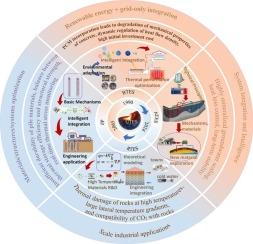地下储热研究进展:研究内容、热点与发展趋势
IF 11
1区 工程技术
Q1 ENERGY & FUELS
引用次数: 0
摘要
现有的地下储热研究文献往往是碎片化的,缺乏对研究热点时空演变的分析。本研究旨在客观、全面地分析全球UTSES领域的发展轨迹和研究趋势。本研究以近30年来出版的7705篇文献为数据源,运用知识图谱技术进行文献计量学和内容分析。它主要关注三个核心问题:研究前沿和技术成熟度、核心瓶颈、未来趋势和成本特征。其目的是克服传统定性审查的局限性,并建立一个数据驱动的多维分析框架。结果表明,UTES领域经历了萌芽、稳定生长和快速扩张三个发展阶段,预计到2065年将实现大规模商业化。含水层储热研究的重点是热-流-固耦合优化。钻孔储热(BTES)强调相变材料与可再生能源的结合。能源桩是连接地下结构与能源系统的关键环节。岩石热能存储(RTES)正转向高温材料创新,EP的研究强度显著提高。成本排序为:EP <; (BTES,废矿类型;ATES,有现有井再利用)< (BTES,无现有井)< (ATES,无现有井)<; RTES。通过定量分析和预测模型,为uts技术创新、合作建立和政策制定提供科学依据。大大提高了蓄热系统设计的科学严谨性和工程转化效率。本文章由计算机程序翻译,如有差异,请以英文原文为准。

Progress in underground thermal energy storage: research contents, hotspots, and development trends
Existing reviews on underground thermal energy storage (UTES) are often fragmented and lack analysis of the spatial-temporal evolution of research hotspots. This study aims to provide an objective and comprehensive analysis of the developmental trajectory and research trends in the global UTSES field. This study utilizes 7705 documents published over the past 30 years as its data source to conduct bibliometric and content analysis using knowledge graph techniques. It focuses on three core issues: research frontiers and technology maturity, core bottlenecks, and future trends and cost characteristics. The aim is to overcome the limitations of traditional qualitative reviews and establish a data-driven, multi-dimensional analytical framework. The results indicate that the UTES field has undergone three stages of development: embryonic, stable growth, and rapid expansion, with large-scale commercialization expected by 2065. Aquifer thermal energy storage (ATES) focuses on heat-fluid-solid coupling optimization. Borehole thermal energy storage (BTES) emphasizes the integration of phase-change materials (PCMs) with renewable energy. Energy piles (EPs) serve as a critical key link between underground structures and energy systems. Rock thermal energy storage (RTES) is shifting toward high-temperature material innovations, with EP demonstrating significantly higher research intensity. The cost ranking is as follows: EP < (BTES, abandoned mine type; ATES, with existing well reuse) < (BTES, without existing wells) < (ATES, without existing wells) < RTES. Through quantitative analysis and prediction models, this study provides a scientific basis for UTES technological innovation, collaboration establishment, and policy formulation. Moreover, it significantly enhances the scientific rigor of thermal storage system design and engineering translation efficiency.
求助全文
通过发布文献求助,成功后即可免费获取论文全文。
去求助
来源期刊

Applied Energy
工程技术-工程:化工
CiteScore
21.20
自引率
10.70%
发文量
1830
审稿时长
41 days
期刊介绍:
Applied Energy serves as a platform for sharing innovations, research, development, and demonstrations in energy conversion, conservation, and sustainable energy systems. The journal covers topics such as optimal energy resource use, environmental pollutant mitigation, and energy process analysis. It welcomes original papers, review articles, technical notes, and letters to the editor. Authors are encouraged to submit manuscripts that bridge the gap between research, development, and implementation. The journal addresses a wide spectrum of topics, including fossil and renewable energy technologies, energy economics, and environmental impacts. Applied Energy also explores modeling and forecasting, conservation strategies, and the social and economic implications of energy policies, including climate change mitigation. It is complemented by the open-access journal Advances in Applied Energy.
 求助内容:
求助内容: 应助结果提醒方式:
应助结果提醒方式:


